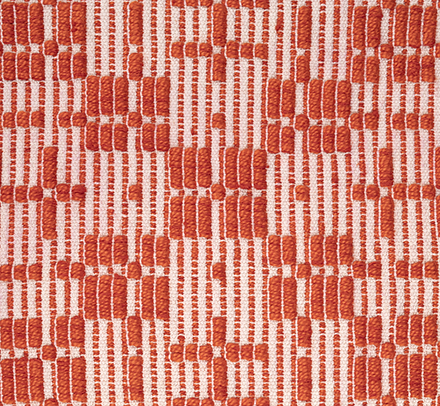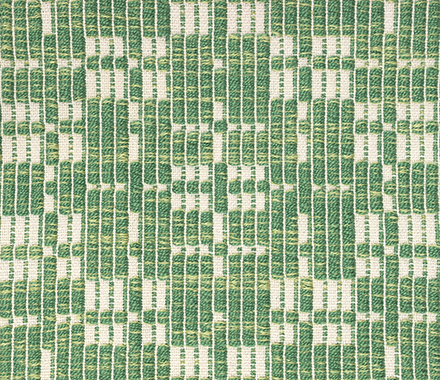| Tied Lithuanian |
Marcy Petrini
July, 2022
Recently my 100-year-old Mom moved to an assistant living facility. As we were packing what she would be taking with her, deep down in a drawer I found a small runner woven in Tied Lithuanian. I had completely forgotten I had given it to her. I wove it with the three colors of the Lithuanian flag: yellow, green and red. The blocks of the green section in the middle are woven with a variegated yarn and treadled differently than the yellow and red sections.

It was a bittersweet finding. On one hand, I am glad to have it because it’s one of the earliest samples of tied unit weaves that I have woven. On the other hand, she must have stashed it away because it was “too precious” to use and ended up not enjoying it. That saddened me.
Mom was born in Lithuania but left as a refugee when the Russians occupied Lithuania during World War II. She was separated from her family. She met my Italian Dad in Germany, they got married and moved to Italy. Dad had been a prisoner of war in Germany because he refused to fight on the Mussolini and Hitler side. Dad was freed by the Americans.

The Vatican hosted several embassies of the countries occupied by the Russians so that the displaced people could keep a community and preserve their heritage. As a child I remember going to the Lithuanian embassy and seeing beautiful regional costumes that the ladies wore. I was in awe of the embroidery. I had learned to embroider from my aunt, but not that intricate!
It turns out that the “embroidery” was actually weaving, and it was many years later that I learned about some of the techniques. Card weaving and pick up are popular, but so is Tied Lithuanian.

Lithuania was freed from the Russian aggression in 1989. I am quite sure that I wove the runner for Mom earlier. I was so inexperienced with tied unit weaves, that I didn’t know what are traditionally considered the front and the back. I can tell from the folded hem that I switched them. Below is the back which I thought was the front.

Ironically, I found the runner when I was in the middle of writing my monograph An Eight-Shaft Primer of Tied Unit Weaves for my upcoming Convergence® seminar. Tied Lithuanian is part of it.
What is Tied Lithuanian? Using Donna Sullivan’s classification from her book Summer & Winter, Tied Lithuanian is a double, two paired ties, with a 1:2 ratio. It means that there are two pattern shafts (“double”) and two ties together (“paired”). For each block the ratio is one tied-down thread for two pattern shafts. The tied-down shafts are 1 and 2. The pattern shafts for block A are 3 and 4.
Tied Lithuanian and Tied Latvian have the same threading. They differ in the treadling.
Below is a sinking shed drawdown. There are three blocks on eight shafts. In this example, each block is repeated. The top portion with the dark pink weft is the Tied Latvian treadling. This is typical of tied unit weaves. Each tie-down shaft is paired with the pattern shafts to treadle the block. The two pattern picks are repeated as needed to square the block.
The bottom portion with the green weft is the Tied Lithuanian treadling. It uses only one pick per block, the one with shaft 1 as the tie-down thread.
In the middle in light blue are the two tabby picks, odd vs. even. As in all tied unit weaves, each pattern pick is flanked by tabby picks.

The runner for Mom was woven on 10 shafts, the directions long gone. We can see the characteristic columns of ties on shaft 1 in the background, on shaft 2 between blocks seen in the drawdown.

Whether you will ever weave Tied Lithuanian or not, there is a lesson to be learned here: use your textiles, those you weave for yourself and those given to you by dear ones. My throws and blankets, woven and knitted, some with handspun, are on all the couches and chairs in our living spaces. They are ready to warm humans and cats. You may think they are worse for wear, but I think they have just been loved.

I hope to see you at Convergence®, maybe even in one of my seminars – vaccinated and masked, we will both be safe.
I would love to see you there!
Happy weaving!
Marcy
